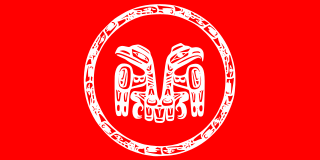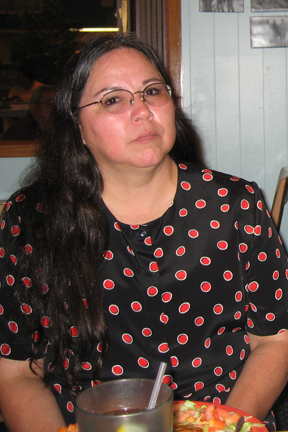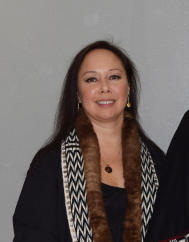Related Research Articles

The Haida are an Indigenous group who have traditionally occupied Haida Gwaii, an archipelago just off the coast of British Columbia, Canada, for at least 12,500 years.

The Museum of Anthropology at the University of British Columbia (UBC) campus in Vancouver, British Columbia, Canada displays world arts and cultures, in particular works by First Nations of the Pacific Northwest. As well as being a major tourist destination, MOA is a research and teaching museum, where UBC courses in art, anthropology, archaeology, conservation, and museum studies are given. MOA houses close to 50,000 ethnographic objects, as well as 535,000 archaeological objects in its building alone.

Haida Gwaii, also known as the Queen Charlotte Islands, is an archipelago located between 55–125 km (34–78 mi) off the northern Pacific coast of Canada. The islands are separated from the mainland to the east by the shallow Hecate Strait. Queen Charlotte Sound lies to the south, with Vancouver Island beyond. To the north, the disputed Dixon Entrance separates Haida Gwaii from the Alexander Archipelago in the U.S. state of Alaska.
Robert Charles Davidson LL. D. D.F.A., is a Canadian artist of Haida heritage. Davidson's Haida name is G̲uud San Glans, which means "Eagle of the Dawn". He is a leading figure in the renaissance of Haida art and culture. He lives in White Rock, British Columbia.

Florence Edenshaw Davidson (1896–1993) was a Canadian First Nations artist from Haida Gwaii. She created basketry and button-blankets and was a respected elder in her village of Masset, Haida Gwaii, British Columbia.

Charles Edenshaw was a Haida artist from Haida Gwaii, British Columbia. He is known for his woodcarving, argillite carving, jewellery, and painting. His style was known for its originality and innovative narrative forms, created while adhering to the principles of formline art characteristic of Haida art. In 1902, the ethnographer and collector Charles F. Newcombe called Edenshaw “the best carver in wood and stone now living.”

Northwest Coast art is the term commonly applied to a style of art created primarily by artists from Tlingit, Haida, Heiltsuk, Nuxalk, Tsimshian, Kwakwaka'wakw, Nuu-chah-nulth and other First Nations and Native American tribes of the Northwest Coast of North America, from pre-European-contact times up to the present.
Michael Nicoll Yahgulanaas is a visual artist, author, and public speaker. His work has been seen in public spaces, museums, galleries and private collections across globe. Institutional collections include the British Museum, Metropolitan Museum of Art, Seattle Art Museum, Vancouver Art Gallery, and the Humboldt Forum.

Coast Salish art is an art unique to the Pacific Northwest Coast among the Coast Salish peoples. Coast Salish are peoples from the Pacific Northwest Coast made up of many different languages and cultural characteristics. Coast Salish territory covers the coast of British Columbia and Washington state. Within traditional Coast Salish art there are two major forms; the flat design and carving, and basketry and weaving. In historical times these were delineated among male and female roles in the community with men made "figurative pieces, such as sculptures and paintings that depicts crest, shamanic beings, and spirits, whereas women produced baskets and textiles, most often decorated with abstract designs."

Delores E. Churchill is a Native American artist of Haida descent. She is a weaver of baskets, hats, robes, and other regalia, as well as leading revitalization efforts for Haida, her native language.

Chilkat weaving is a traditional form of weaving practiced by Tlingit, Haida, Tsimshian, and other Northwest Coast peoples of Alaska and British Columbia. Chilkat robes are worn by high-ranking tribal members on civic or ceremonial occasions, including dances. The blankets are almost always black, white, yellow and blue.
Dorothy Grant is an Indigenous fashion designer whose works have gained public recognition as expressions of living Haida culture.
Primrose Adams was a Canadian First Nations artist and member of the Raven Clan from the Haida nation. She wove hats and baskets in the Haida method and is most notable for her spruce root basketry, which involves working in the traditional manner of collecting and dyeing her own spruce root. Adams died in January 2020.

Formline art is a feature in the indigenous art of the Northwest Coast of North America, distinguished by the use of characteristic shapes referred to as ovoids, U forms and S forms. Coined by Bill Holm in his 1965 book Northwest Coast Indian Art: An Analysis of Form, the "formline is the primary design element on which Northwest Coast art depends, and by the turn of the 20th century, its use spread to the southern regions as well. It is the positive delineating force of the painting, relief and engraving. Formlines are continuous, flowing, curvilinear lines that turn, swell and diminish in a prescribed manner. They are used for figure outlines, internal design elements and in abstract compositions."

Teri Rofkar, or Chas' Koowu Tla'a (1956–2016), was a Tlingit weaver and educator from Sitka, Alaska. She specialized in Ravenstail designs and spruce root baskets.
Isabella Edenshaw was a First Nations basket weaver who lived in Haida Gwaii. She was given this name by an Anglican priest when she was married. She is also known by the Haida names K'woiyeng, Yahgujanaas and S'itkwuns. Some sources list her birth year as 1858.

Lisa Telford is a Git'ans Git'anee Haida weaver who creates contemporary garments, shoes and other objects using Northwest Coast style weaving techniques. Her work serves as a commentary on Native identity, stereotypes and fashion.
Lily Hope is an Alaska Native artist, designer, teacher, weaver, Financial Freedom planner, and community facilitator. She is primarily known for her skills at weaving customary Northwest Coast ceremonial regalia such as Chilkat robes and ensembles. She owns a public-facing studio in Juneau, called Wooshkindein Da.àat: Lily Hope Weaver Studio which opened downtown in 2022. Lily Hope is a mother of five children, and works six days a week.

Lisa Hageman Yahgulanaas is a Haida weaver. She is from Haida Gwaii and is based in Masset. She has won multiple awards in British Columbia.

Ravenstail weaving, also known as Raven's Tail weaving, is a traditional form of geometric weaving-style practiced by Northwest Coast peoples.
References
- 1 2 3 4 5 "Evelyn Vanderhoop". BC Achievement Foundation. Retrieved 14 January 2024.
- ↑ Tacmanlast, Tacman. "2020 Sinton Lecture: Northwest Coast Wool Textiles". Textile Arts Council, Fine Arts Museum of San Francisco. Retrieved 2021-04-23.
- ↑ Jill Ahlberg Yohe; Teri Greeves (2019). Hearts of Our People: Native Women Artists. Minneapolis: Minneapolis Institute of Art. ISBN 978-0-295-74579-4. OCLC 1057740182.
- ↑ Holm, Bill (2017-01-03). Northwest Coast Indian Art: An Analysis of Form, 50th Anniversary Edition. University of Washington Press. ISBN 978-0-295-99950-0.
- ↑ "Collections Spotlight with Evelyn Vanderhoop > Coe Center". Coe Center. 2020-11-19. Retrieved 2021-04-23.
- ↑ "Entwined with Life: Native American Basketry - NW Coast Weavers - Burke Museum". www.burkemuseum.org. Retrieved 2021-04-23.
- ↑ Bunn-Marcuse, Kathryn; Jonaitis, Aldona (2020-05-29). Unsettling Native Art Histories on the Northwest Coast. University of Washington Press. ISBN 978-0-295-74714-9.
- ↑ Anthropology, University of Pennsylvania Museum of Archaeology and; Williams, Lucy Fowler (2003). Guide to the North American Ethnographic Collections at the University of Pennsylvania Museum of Archaeology and Anthropology. UPenn Museum of Archaeology. ISBN 978-1-931707-32-9.
- ↑ "Raven's Tail Ceremonial Robe, Ripple in the Sky Robe". Canadian Museum of History.
- 1 2 3 Tepper, Leslie (2014). The Grand Hall: First Peoples of Canada's Northwest Coast. Library and Archives Canada. p. 103. ISBN 9780660202792.
- ↑ "Collections Spotlight with Evelyn Vanderhoop > Coe Center". Coe Center. 2020-11-19. Retrieved 2021-04-23.
- ↑ Raven's Tail Journey of Evelyn Vanderhoop , retrieved 2021-04-23
- ↑ "Evelyn Vanderhoop's Ravenstail Robe Enters the Collection of the MFA Boston". Stonington Gallery. 2019-02-13. Retrieved 2021-04-23.
- ↑ In the Spirit of the Ancestors: Contemporary Northwest Coast Art at the Burke Museum. Bill Holm Center for the Study of Northwest Coast Art, Burke Museum. 2013.